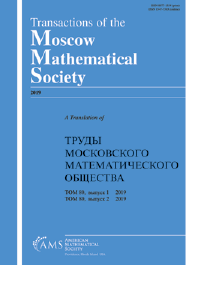Unimodular triangulations of dilated 3-polytopes
HTML articles powered by AMS MathViewer
- by F. Santos and G. M. Ziegler
- Trans. Moscow Math. Soc. 2013, 293-311
- DOI: https://doi.org/10.1090/S0077-1554-2014-00220-X
- Published electronically: April 9, 2014
Abstract:
A seminal result in the theory of toric varieties, by Knudsen, Mumford and Waterman (1973), asserts that for every lattice polytope $P$ there is a positive integer $k$ such that the dilated polytope $kP$ has a unimodular triangulation. In dimension 3, Kantor and Sarkaria (2003) have shown that $k=4$ works for every polytope. But this does not imply that every $k>4$ works as well. We here study the values of $k$ for which the result holds, showing that:
-
It contains all composite numbers.
-
It is an additive semigroup.
These two properties imply that the only values of $k$ that may not work (besides $1$ and $2$, which are known not to work) are $k\in \{3,5,7,11\}$. With an ad-hoc construction we show that $k=7$ and $k=11$ also work, except in this case the triangulation cannot be guaranteed to be “standard” in the boundary. All in all, the only open cases are $k=3$ and $k=5$.
References
- Winfried Bruns and Joseph Gubeladze, Polytopes, rings, and $K$-theory, Springer Monographs in Mathematics, Springer, Dordrecht, 2009. MR 2508056, DOI 10.1007/b105283
- Jesús A. De Loera, Jörg Rambau, and Francisco Santos, Triangulations, Algorithms and Computation in Mathematics, vol. 25, Springer-Verlag, Berlin, 2010. Structures for algorithms and applications. MR 2743368, DOI 10.1007/978-3-642-12971-1
- J.-M. Kantor and K. S. Sarkaria, On primitive subdivisions of an elementary tetrahedron, Pacific J. Math. 211 (2003), no. 1, 123–155. MR 2016594, DOI 10.2140/pjm.2003.211.123
- Knudsen F. F. Construction of nice polyhedral subdivisions, Chapter 3 of “Toroidal Embeddings I” by G. R. Kempf, F. F. Knudsen, D. Mumford, and B. Saint-Donat, Lecture Notes in Mathematics. 1973. Vol. 339, 109–164.
- J. E. Reeve, On the volume of lattice polyhedra, Proc. London Math. Soc. (3) 7 (1957), 378–395. MR 0095452, DOI 10.1112/plms/s3-7.1.378
- Reznick B. Clean lattice tetrahedra, preprint, June 2006, 21 pages, arXiv:0606227.
- Herbert E. Scarf, Integral polyhedra in three space, Math. Oper. Res. 10 (1985), no. 3, 403–438. MR 798388, DOI 10.1287/moor.10.3.403
- András Sebő, An introduction to empty lattice simplices, Integer programming and combinatorial optimization (Graz, 1999) Lecture Notes in Comput. Sci., vol. 1610, Springer, Berlin, 1999, pp. 400–414. MR 1709397, DOI 10.1007/3-540-48777-8_{3}0
- G. K. White, Lattice tetrahedra, Canadian J. Math. 16 (1964), 389–396. MR 161837, DOI 10.4153/CJM-1964-040-2
Bibliographic Information
- F. Santos
- Affiliation: Facultad de Ciencias, Universidad de Cantabria, Spain
- MR Author ID: 360182
- ORCID: 0000-0003-2120-9068
- Email: francisco.santos@unican.es
- G. M. Ziegler
- Affiliation: Inst. Mathematics, FU Berlin, Germany
- Email: ziegler@math.fu-berlin.de
- Published electronically: April 9, 2014
- Additional Notes: The work of the first author was supported in part by the Spanish Ministry of Science under Grants MTM2011-22792 and by MICINN-ESF EUROCORES programme EuroGIGA— ComPoSe — IP04 (Project EUI-EURC-2011-4306). Part of this work was done while the first author was visiting FU Berlin in 2012 and 2013 supported by a Research Fellowship of the Alexander von Humboldt Foundation.
The work of the second author was supported by the European Research Council under the European Union’s Seventh Framework Programme (FP7/2007-2013)/ERC Grant agreement no. 247029-SDModels and by the DFG Research Center Matheon “Mathematics for Key Technologies” in Berlin - © Copyright 2014 F. Santos, G. M. Ziegler
- Journal: Trans. Moscow Math. Soc. 2013, 293-311
- MSC (2010): Primary 52B20, 14M25
- DOI: https://doi.org/10.1090/S0077-1554-2014-00220-X
- MathSciNet review: 3235802


